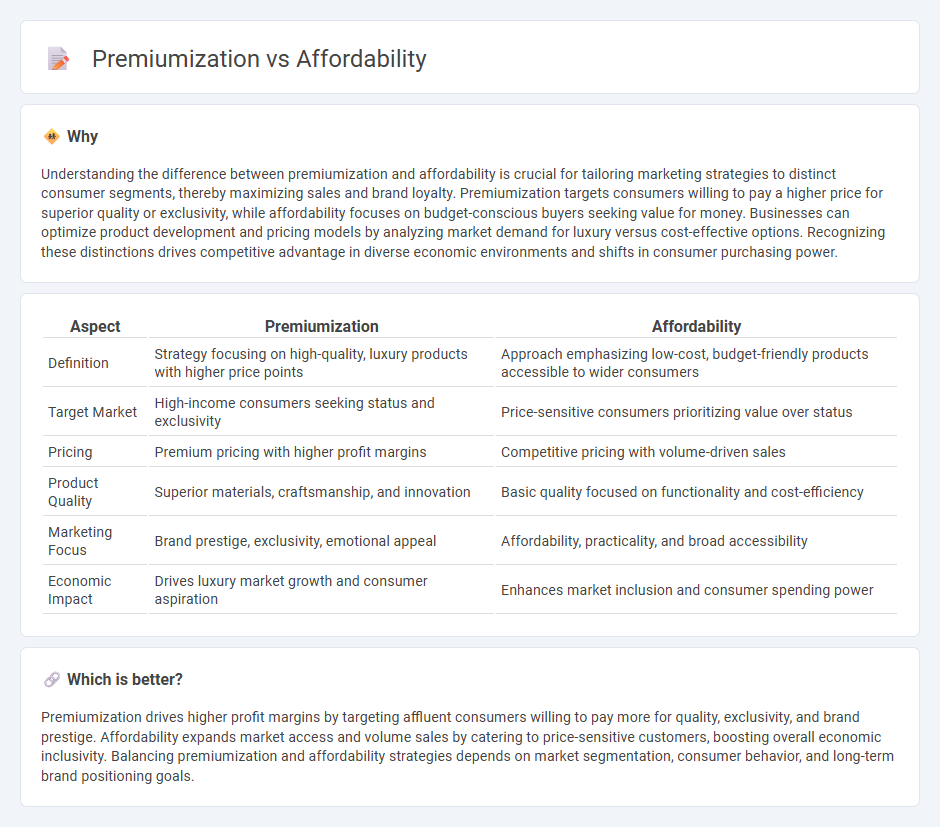
Premiumization drives economic growth by targeting consumers willing to pay more for higher quality and exclusive products, boosting brand value and profit margins. Affordability focuses on expanding market reach through cost-effective pricing, increasing accessibility for a broader demographic and stimulating volume sales. Explore how balancing premiumization and affordability shapes market dynamics and consumer behavior.
Why it is important
Understanding the difference between premiumization and affordability is crucial for tailoring marketing strategies to distinct consumer segments, thereby maximizing sales and brand loyalty. Premiumization targets consumers willing to pay a higher price for superior quality or exclusivity, while affordability focuses on budget-conscious buyers seeking value for money. Businesses can optimize product development and pricing models by analyzing market demand for luxury versus cost-effective options. Recognizing these distinctions drives competitive advantage in diverse economic environments and shifts in consumer purchasing power.
Comparison Table
| Aspect | Premiumization | Affordability |
|---|---|---|
| Definition | Strategy focusing on high-quality, luxury products with higher price points | Approach emphasizing low-cost, budget-friendly products accessible to wider consumers |
| Target Market | High-income consumers seeking status and exclusivity | Price-sensitive consumers prioritizing value over status |
| Pricing | Premium pricing with higher profit margins | Competitive pricing with volume-driven sales |
| Product Quality | Superior materials, craftsmanship, and innovation | Basic quality focused on functionality and cost-efficiency |
| Marketing Focus | Brand prestige, exclusivity, emotional appeal | Affordability, practicality, and broad accessibility |
| Economic Impact | Drives luxury market growth and consumer aspiration | Enhances market inclusion and consumer spending power |
Which is better?
Premiumization drives higher profit margins by targeting affluent consumers willing to pay more for quality, exclusivity, and brand prestige. Affordability expands market access and volume sales by catering to price-sensitive customers, boosting overall economic inclusivity. Balancing premiumization and affordability strategies depends on market segmentation, consumer behavior, and long-term brand positioning goals.
Connection
Premiumization drives consumers to seek higher-quality products that offer enhanced value, often justifying a higher price point. Affordability ensures these premium goods remain accessible to a broader audience, balancing exclusivity with mass appeal. This connection influences market strategies by encouraging brands to innovate while maintaining competitive pricing to capture diverse consumer segments.
Key Terms
Price Elasticity
Price elasticity significantly influences consumer behavior in affordability versus premiumization dynamics, with affordable products experiencing higher sensitivity to price changes and premium products showing more inelastic demand. Properly understanding price elasticity helps businesses optimize pricing strategies, balancing value perception and cost efficiency to maximize revenue across market segments. Explore detailed insights on price elasticity effects in both affordability and premium market strategies.
Value Proposition
Balancing affordability and premiumization hinges on delivering a compelling value proposition that resonates with target consumers seeking quality and cost-effectiveness. Brands must strategically position products by integrating high-end features with accessible price points to satisfy diverse market segments. Discover how optimizing your value proposition enhances competitive advantage and drives customer loyalty.
Consumer Segmentation
Consumer segmentation distinguishes affordability seekers valuing cost-efficiency from premiumization enthusiasts prioritizing quality and exclusivity. Brands tailor product features, pricing, and marketing strategies to align with each segment's purchasing behavior and lifestyle preferences. Explore how precise segmentation drives targeted growth and customer loyalty in competitive markets.
Source and External Links
Home Ownership Affordability Monitor - The Federal Reserve Bank of Atlanta provides a monthly measure of a median-income household's ability to afford a median-priced home, using a 30% income share threshold to define affordability.
Affordability Calculator - How Much House Can I Afford? - Zillow - Zillow's affordability calculator estimates how much house you can afford based on income, debts, down payment, interest rates, and other costs like taxes and insurance.
What is housing affordability? | Cost of Home - Habitat for Humanity - Housing affordability means paying no more than 30% of income for housing costs; currently, over 20 million U.S. households pay more than half their income for housing, highlighting an affordability crisis.
 dowidth.com
dowidth.com